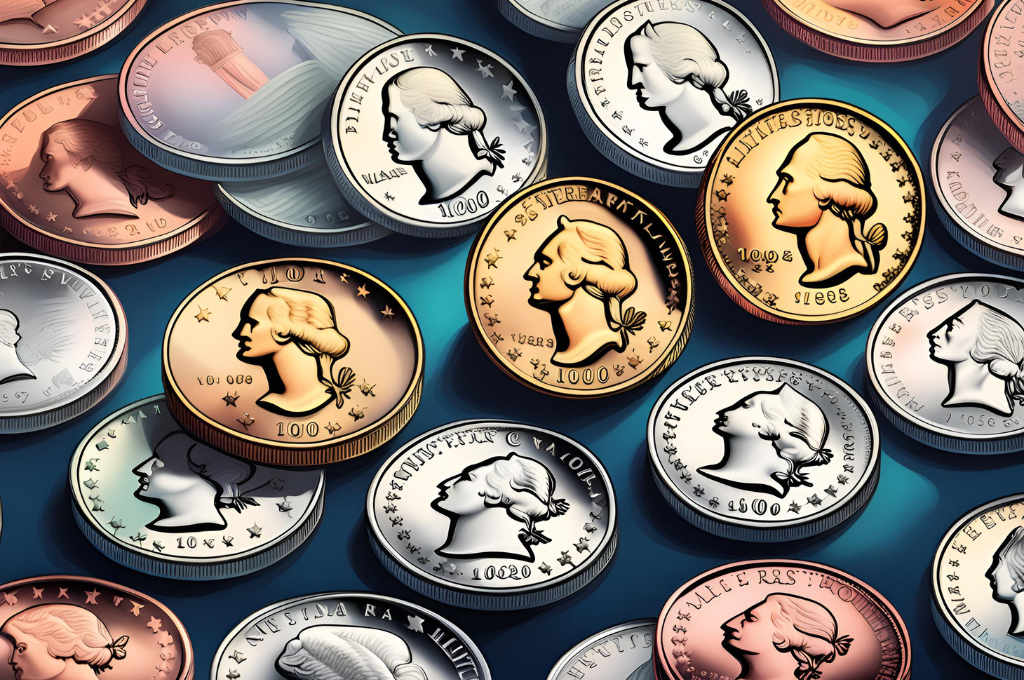Collecting state quarters can be a rewarding hobby, especially when you discover that some of these coins are worth significantly more than their face value. These rare quarters, often sought after by collectors, can fetch a hefty price due to their scarcity, errors, or unique features. Here are ten rare state quarters that you should keep an eye out for, as they could be worth more than you think.
1. 1999-P Delaware Spitting Horse Quarter
The Delaware state quarter features a rider on horseback. However, some of these quarters have a unique die crack that makes it appear as though the horse is spitting. This error has made these coins highly collectible. Depending on their condition, these quarters can sell for anywhere from $5 to $20.
2. 2004-D Wisconsin Extra Leaf High and Low Quarters
The Wisconsin state quarter is notable for two distinct varieties known as the “extra leaf high” and “extra leaf low” errors. These coins feature an additional leaf on the corn stalk, which wasn’t part of the original design. These rare errors can significantly increase the coin’s value, often selling for $50 to $300.
3. 2005-P Minnesota Double Die Quarter
The Minnesota state quarter is famous among collectors due to the “double die” error. This occurs when the coin’s design is struck twice, creating a noticeable doubling effect. Depending on the severity of the error, these quarters can be worth anywhere from $25 to over $100.
4. 2000-P South Carolina Quarter (Wounded Eagle)
Some 2000-P South Carolina quarters exhibit an error known as the “wounded eagle.” This refers to a die gouge that makes it look like the eagle on the coin has been struck. These quarters are rare and can sell for $5 to $50 based on their condition.
5. 2009-D District of Columbia Double Die Quarter
The District of Columbia quarter from 2009 has a notable double die error. The doubling is typically found in the inscriptions on the coin, making it quite distinct. These quarters can fetch prices ranging from $10 to $50, depending on the clarity of the doubling and the coin’s overall condition.
6. 2001-P Kentucky Quarter (Doubled Die)
Another sought-after coin is the 2001-P Kentucky quarter with a doubled die error. This error can be observed in the inscriptions and details of the coin. These rare quarters can sell for $10 to $50, making them a valuable addition to any collection.
7. 2004-P Iowa Quarter (Extra Corn Leaf)
The 2004-P Iowa quarter has an error similar to the Wisconsin quarter, known as the “extra corn leaf” error. This additional leaf on the corn stalk was not part of the original design, making these quarters quite rare and valuable. They can be worth $20 to $100 based on their condition.
8. 2006 Colorado Quarter (Cud Error)
A “cud error” occurs when a piece of the die breaks off, leaving a raised lump on the coin. The 2006 Colorado quarter is known for such an error, usually found near the top of the coin. These quarters are rare and can be worth $5 to $20.
9. 2005 Kansas Quarter (In God We Rust)
One of the more famous error coins is the 2005 Kansas quarter, where the motto “In God We Trust” appears as “In God We Rust” due to a grease-filled die. This error has made these quarters highly collectible, with values ranging from $10 to $50 depending on their condition.
10. 2009-P Northern Mariana Islands Quarter (Die Crack)
The 2009-P Northern Mariana Islands quarter is notable for a die crack error. This crack can appear in various places on the coin, often near the edges. These errors increase the coin’s value, with prices ranging from $5 to $20 based on the size and location of the crack.
Conclusion
Collecting state quarters can be an exciting and potentially profitable hobby. These rare quarters, whether due to errors or unique features, are highly sought after by collectors. If you come across any of these coins, be sure to check their condition and consider having them appraised by a professional. You might just find that your spare change is worth more than you ever imagined. Happy collecting!
